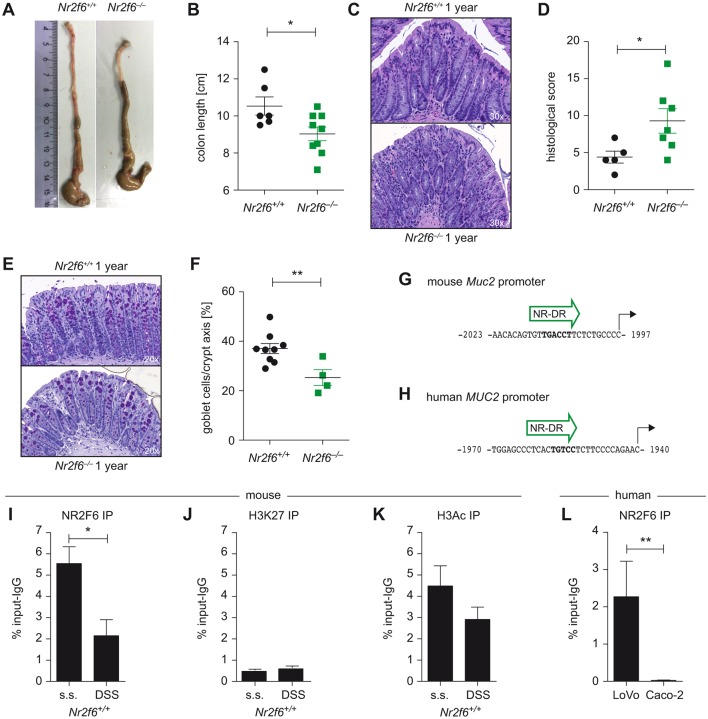Figure 6.
Nr2f6−/− mice develop spontaneous colitis, and NR2F6 directly binds to the Muc2 promoter. (A) Representative pictures of colons of wild-type and Nr2f6−/− 1-year-old female mice with significant shortened colon lengths in Nr2f6−/− mice (n=9) when compared to wild-type (n=6) controls (p=0.027). (C) H&E staining (D) and histological severity scores of colon sections of 1-year-old wild-type and Nr2f6-deficient mice (p=0.042). (E) Representative images of PAS-stained histological colon samples from 1-year-old Nr2f6+/+ and Nr2f6−/− mice showing significantly decreased goblet cell counts per crypt (p=0.007) in Nr2f6-deficient mice (F). (G) A putative nuclear receptor direct repeat site (NR-DR) site at −2 kb of the mouse and (H) human MUC2 gene as predicted by TRANSFAC software is shown. (I) Chromatin immunoprecipitation (ChIP) PCR of the mouse −2 kb promoter region was performed from healthy or DSS diseased (day 3) wild-type colon scrapings with subsequent immunoprecipitation with NR2F6, (K) H3Ac, (J) or H3K27 antibodies. NR2F6 binding was significantly lower (p=0.0362) in the diseased mice, whereas H3Ac or H3K27 binding capability did not change between the two groups (n=3) but was significantly different between the marker for open (H3Ac) and repressed (H3K27) chromatin (p=0.0143). (L) ChIP PCR of the −2 kb huMUC2 promoter region was performed in the human colon carcinoma cell lines LoVo and Caco-2; chromatin was immunoprecipitated with anti-NR2F6; functional binding was significantly lower (p=0.0062) in the low MUC2-secreting Caco-2 colon carcinoma cell line when compared to the high MUC2 LoVo cell line. Data are shown as specific NR2F6 enrichment minus unspecific IgG control (n=4). Data are presented as mean±SEM error bars and are representative of at least two independent experiments. Unpaired Student’s t-test, * p<0.05.

